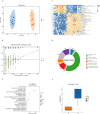The close association of Muribaculum and PA (10:0/a-17:0) with the occurrence of pancreatic ductal adenocarcinoma and immunotherapy
- PMID: 39676871
- PMCID: PMC11638228
- DOI: 10.3389/fimmu.2024.1505966
The close association of Muribaculum and PA (10:0/a-17:0) with the occurrence of pancreatic ductal adenocarcinoma and immunotherapy
Abstract
Background: Progress in immunotherapy for pancreatic ductal adenocarcinoma (PDAC) has been slow, yet the relationship between microorganisms and metabolites is crucial to PDAC development. This study compares the biliary microbiota and metabolomic profiles of PDAC patients with those of benign pancreatic disease patients to investigate PDAC pathogenesis and its relationship with immunotherapy.
Methods: A total of 27 patients were recruited, including 15 diagnosed with PDAC and 12 with benign pancreaticobiliary conditions, all of whom underwent surgical treatment. Intraoperative bile samples were collected and analyzed using 16S rRNA sequencing in conjunction with liquid chromatography-mass spectrometry (LC-MS). Multivariate statistical methods and correlation analyzes were employed to assess differences in microbial composition, structure, and function between malignant and benign pancreatic diseases. Additionally, a retrospective analysis was conducted on PDAC patients post-surgery regarding immunotherapy and its correlation with metabolic components.
Results: PDAC patients exhibited a significantly higher abundance of bile microbiota compared to controls, with notable differences in microbiota structure between the two groups (P < 0.05). At the genus level, Muribaculum was markedly enriched in the bile of PDAC patients and was strongly correlated with phosphatidic acid (PA) (10:0/a-17:0). Both of these components, along with the tumor marker CA199, formulated a predictor of PDAC. Furthermore, PA (10:0/a-17:0) demonstrated a strong correlation with PDAC immunotherapy outcomes (Rho: 0.758; P=0.011).
Conclusion: These findings suggest that the biliary microbiota and associated metabolites play a crucial role in the development of PDAC and may serve as potential predictive biomarkers and therapeutic targets for disease management.
Keywords: 16S rRNA sequencing; PDAC; bile; immunotherapy; metabolomics.
Copyright © 2024 Wang, Ren, Wang, Du, Gao, Niu, Guan, Liu, Wu, Liu, Yu and Song.
Conflict of interest statement
The authors declare that the research was conducted in the absence of any commercial or financial relationships that could be construed as a potential conflict of interest.
Figures





Similar articles
-
Alterations of the bile microbiome is associated with progression-free survival in pancreatic ductal adenocarcinoma patients.BMC Microbiol. 2024 Jul 1;24(1):235. doi: 10.1186/s12866-024-03371-9. BMC Microbiol. 2024. PMID: 38956452 Free PMC article.
-
Distinct composition and metabolic potential of biliary microbiota in patients with malignant bile duct obstruction.Eur J Gastroenterol Hepatol. 2025 May 1;37(5):585-593. doi: 10.1097/MEG.0000000000002948. Epub 2025 Mar 26. Eur J Gastroenterol Hepatol. 2025. PMID: 40207470 Free PMC article.
-
Bile Microbiome Signatures Associated with Pancreatic Ductal Adenocarcinoma Compared to Benign Disease: A UK Pilot Study.Int J Mol Sci. 2023 Nov 28;24(23):16888. doi: 10.3390/ijms242316888. Int J Mol Sci. 2023. PMID: 38069211 Free PMC article.
-
Immunotherapeutic strategies in pancreatic ductal adenocarcinoma (PDAC): current perspectives and future prospects.Mol Biol Rep. 2020 Aug;47(8):6269-6280. doi: 10.1007/s11033-020-05648-4. Epub 2020 Jul 13. Mol Biol Rep. 2020. PMID: 32661873 Review.
-
Immunotherapy in pancreatic ductal adenocarcinoma: an emerging entity?Ann Oncol. 2017 Dec 1;28(12):2950-2961. doi: 10.1093/annonc/mdx503. Ann Oncol. 2017. PMID: 28945842 Free PMC article. Review.
References
MeSH terms
Substances
LinkOut - more resources
Full Text Sources
Medical

